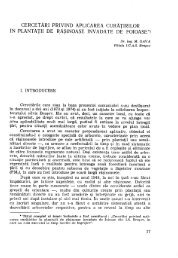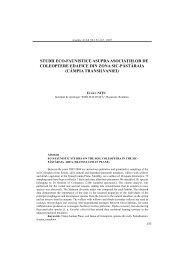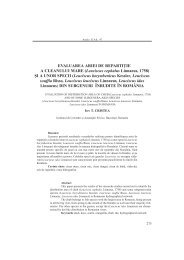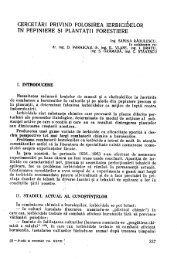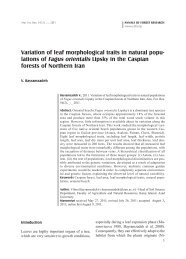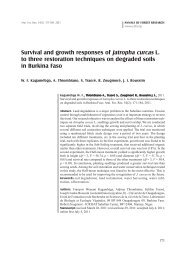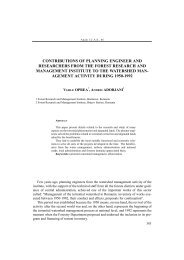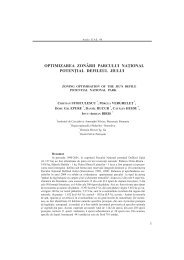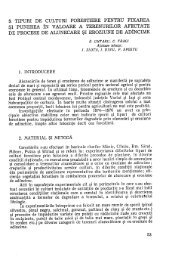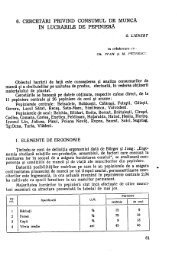Ann. For. Res. 54(1): 57-71, 201166m30m29m28m27m26m25m24m23m22m21m20m19m18m17m16m15m14m13m12m11m10m9m8m7m6m5m4m3m2m10 10 20Figure 2 Frequencies of mycorrhizal morphotypesin <strong>ro</strong>ot samples of Quecus <st<strong>ro</strong>ng>cerris</st<strong>ro</strong>ng>,<st<strong>ro</strong>ng>Quercus</st<strong>ro</strong>ng> <st<strong>ro</strong>ng>frainetto</st<strong>ro</strong>ng> <st<strong>ro</strong>ng>and</st<strong>ro</strong>ng> <st<strong>ro</strong>ng>Quercus</st<strong>ro</strong>ng> <st<strong>ro</strong>ng><strong>ro</strong>bur</st<strong>ro</strong>ng>in several locations in Southern <st<strong>ro</strong>ng>and</st<strong>ro</strong>ng>North-Western <st<strong>ro</strong>ng>Romania</st<strong>ro</strong>ng>Research articlesity-dissimilarity matrix was used for clusteringby means of g<strong>ro</strong>up average method. Statisticaltests were performed using KyPlot p<strong>ro</strong>gram.ResultsThere were identied 30 morphotypes of ectomycorrhizae,corresponding to <st<strong>ro</strong>ng>Quercus</st<strong>ro</strong>ng> <st<strong>ro</strong>ng><strong>ro</strong>bur</st<strong>ro</strong>ng>,<st<strong>ro</strong>ng>Quercus</st<strong>ro</strong>ng> <st<strong>ro</strong>ng>cerris</st<strong>ro</strong>ng> <st<strong>ro</strong>ng>and</st<strong>ro</strong>ng> <st<strong>ro</strong>ng>Quercus</st<strong>ro</strong>ng> <st<strong>ro</strong>ng>frainetto</st<strong>ro</strong>ng> in Southern,Western <st<strong>ro</strong>ng>and</st<strong>ro</strong>ng> North-Western locations,presented in Table 1. The original descriptions(with the exception of Cenoccocum geophilumdescribed by Agerer in 1987), are presented inTable 2.The investigation of the maximum numbe<strong>ro</strong>f morphotypes active a certain moment in therhizosphere of the host is 14 (Fig. 1) which isthe real instantaneous value of morphotyperichness (Q. <st<strong>ro</strong>ng>cerris</st<strong>ro</strong>ng> at Dobreti).The described morphotypes include only 6cases of identied mycobionts (Amanita maireiFoley, Scle<strong>ro</strong>derma citrinum Pers., Russulaat<strong>ro</strong>purpurea (K<strong>ro</strong>mbh.) Britzelm, Lactariusquietus (Fr.) Fr., Russula virescens (Schaeff.)Fr., Boletus chrysente<strong>ro</strong>n Bull.) based on mycelialcontinuity between mycorrhizal mantle<st<strong>ro</strong>ng>and</st<strong>ro</strong>ng> the mycelium at the base of the carpophores.Easily recognizable Cenoccocumgeophilum Fr. is also included in morphotypedescriptions. Mantles of mycorrhizas with speciesof Lactarius as mycobionts (as examinedon c<strong>ro</strong>ss sections of ne <strong>ro</strong>ots) exhibit characteristiclaticifers <st<strong>ro</strong>ng>and</st<strong>ro</strong>ng> pigments which are alsofound in the structure of the spo<strong>ro</strong>carps. Thoseof Rusulla spp. exhibit distinctive cystidia <st<strong>ro</strong>ng>and</st<strong>ro</strong>ng>sulfovaniline reactive cells (Kernaghan <st<strong>ro</strong>ng>and</st<strong>ro</strong>ng>Currah 1997).The analysis of frequency distribution of thevarious morphotypes (Fig. 2) shows that thedominating type is Cenococcum geophilum(M30) that is present in all locations. Nextmost frequent morphotype is M2 described inQ. <st<strong>ro</strong>ng><strong>ro</strong>bur</st<strong>ro</strong>ng> <st<strong>ro</strong>ng>and</st<strong>ro</strong>ng> Q. <st<strong>ro</strong>ng>cerris</st<strong>ro</strong>ng> at Buteni, Oradea <st<strong>ro</strong>ng>and</st<strong>ro</strong>ng>Slveti but found in almost all locations lessfrequently than C.geophilum.
Fodor et al. Mycorrhizal status of several <st<strong>ro</strong>ng>Quercus</st<strong>ro</strong>ng> species in <st<strong>ro</strong>ng>Romania</st<strong>ro</strong>ng> ...Table 4 The Yule coefcient of association of Cenococcum geophilum with several other mycorrhizal morphotypes in <st<strong>ro</strong>ng>Quercus</st<strong>ro</strong>ng> <st<strong>ro</strong>ng>cerris</st<strong>ro</strong>ng>, DobretiAssociationYule coefcient of associationC. geophilum + M10 -0.8004C. geophilum + M17 -0.1287C. geophilum + M8 0.2564C. geophilum + M3 0.2467C. geophilum + M11 -0.0943C. geophilum associates either r<st<strong>ro</strong>ng>and</st<strong>ro</strong>ng>omlywith other morphotypes in the same mycorrhizalsystem (values close to 0), or excludesother morphotypes (value close to -1 in the associationwith M10) according to our results, apattern consistent with its dominating position.It is also the most frequent <st<strong>ro</strong>ng>and</st<strong>ro</strong>ng> b<strong>ro</strong>ad spectrumhost associated mycorrhizal type as other authorsreport (Moser et al. 2005).The comparison of the mycorrhizal status(relative frequencies of active mycorrhizal apices)among 5 samples of <strong>ro</strong>ots f<strong>ro</strong>m <st<strong>ro</strong>ng>Quercus</st<strong>ro</strong>ng><st<strong>ro</strong>ng>cerris</st<strong>ro</strong>ng> at Dobreti by of one way ANOVA resultedin no signicant differences at p > 0.05.Also Tukey test for pair-wise multiple comparisonsdidn’t reveal any signicant differencesbetween samples.Søresen similarity index (Table 4) calculatedin order to compare locations <st<strong>ro</strong>ng>and</st<strong>ro</strong>ng> <st<strong>ro</strong>ng>Quercus</st<strong>ro</strong>ng>species (within site <st<strong>ro</strong>ng>and</st<strong>ro</strong>ng> between sites) showmaximum values in the following cases: <st<strong>ro</strong>ng>Quercus</st<strong>ro</strong>ng><st<strong>ro</strong>ng>frainetto</st<strong>ro</strong>ng> at Tinca with <st<strong>ro</strong>ng>Quercus</st<strong>ro</strong>ng> <st<strong>ro</strong>ng>cerris</st<strong>ro</strong>ng> atOradea (0.72), <st<strong>ro</strong>ng>Quercus</st<strong>ro</strong>ng> <st<strong>ro</strong>ng><strong>ro</strong>bur</st<strong>ro</strong>ng> at Buteni with<st<strong>ro</strong>ng>Quercus</st<strong>ro</strong>ng> <st<strong>ro</strong>ng><strong>ro</strong>bur</st<strong>ro</strong>ng> in the city of Oradea (0.61),<st<strong>ro</strong>ng>Quercus</st<strong>ro</strong>ng> <st<strong>ro</strong>ng>cerris</st<strong>ro</strong>ng> <st<strong>ro</strong>ng>and</st<strong>ro</strong>ng> <st<strong>ro</strong>ng>Quercus</st<strong>ro</strong>ng> <st<strong>ro</strong>ng>frainetto</st<strong>ro</strong>ng> at MihaiBravu (0.57).The analysis of the dend<strong>ro</strong>gram resultedf<strong>ro</strong>m the ordination of Sørensen similarity matrix,comparing different sites <st<strong>ro</strong>ng>and</st<strong>ro</strong>ng> tree hostswith regard to identied morphotypes (Fig. 3),reects the association between similar siteswithin same geographical <st<strong>ro</strong>ng>and</st<strong>ro</strong>ng> meso-climaticarea. Within same location, different host speciesare highly similar with respect to their mycorrhizalassociates, such as Q. <st<strong>ro</strong>ng>cerris</st<strong>ro</strong>ng> <st<strong>ro</strong>ng>and</st<strong>ro</strong>ng> Q.<st<strong>ro</strong>ng>frainetto</st<strong>ro</strong>ng> at Dobreti or Tinca (South-West atMihai Bravu).A distinct cluster is formed by hosts locatedin forest st<st<strong>ro</strong>ng>and</st<strong>ro</strong>ng>s f<strong>ro</strong>m Southern <st<strong>ro</strong>ng>Romania</st<strong>ro</strong>ng> wherethese are vegetating in the plain <st<strong>ro</strong>ng>and</st<strong>ro</strong>ng> are exposedto temperate-continental climate withharsh winters <st<strong>ro</strong>ng>and</st<strong>ro</strong>ng> dry summers. Another distinctcluster is formed by hosts vegetating inst<st<strong>ro</strong>ng>and</st<strong>ro</strong>ng>s f<strong>ro</strong>m Mihai Bravu, in the Neajlov riverdelta, characterized by wetter soil conditionsas compared to other Southern locations. However,Q. <st<strong>ro</strong>ng>frainetto</st<strong>ro</strong>ng> f<strong>ro</strong>m Comana, a nearby location,to Mihai Bravu clusters together withother Southern locations characterized bydrier soil conditions. North Western locationscluster, together presents same pattern of associationwith their mycobionts, including aslocation Tinca <st<strong>ro</strong>ng>and</st<strong>ro</strong>ng> Oradea. <st<strong>ro</strong>ng>Quercus</st<strong>ro</strong>ng> <st<strong>ro</strong>ng><strong>ro</strong>bur</st<strong>ro</strong>ng> ishighly dissimilar to other host species withregard to associated mycobionts <st<strong>ro</strong>ng>and</st<strong>ro</strong>ng> clustersseparately. Recurrent associations, in this caseof ectomycorrhizal mophotypes, correspondto fundamental p<strong>ro</strong>perties of the interactionbetween species <st<strong>ro</strong>ng>and</st<strong>ro</strong>ng> their physical (site) <st<strong>ro</strong>ng>and</st<strong>ro</strong>ng>biotic envi<strong>ro</strong>nment (hosts) (Legendre & Legendre,1998).Previous studies (Timofte 2007) reported thepossibility to obtain mic<strong>ro</strong>p<strong>ro</strong>pagated plantletsof Q. <st<strong>ro</strong>ng><strong>ro</strong>bur</st<strong>ro</strong>ng> <st<strong>ro</strong>ng>and</st<strong>ro</strong>ng> Q. <st<strong>ro</strong>ng>frainetto</st<strong>ro</strong>ng> by means of somaticembryogenesis initiated f<strong>ro</strong>m acorns.The embryos can be converted to plantletswhich, theoretically, can be outplanted.DiscussionThe energy ow th<strong>ro</strong>ugh the mycorrhizal networksrepresents a major food chain in the forestt<strong>ro</strong>phic web. The network represented by67



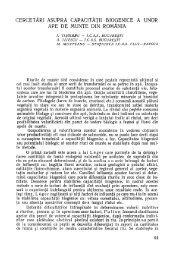
![studiu privind conditiilb] de vegetatie ale ... - EdituraSilvica.ro](https://img.yumpu.com/50877313/1/175x260/studiu-privind-conditiilb-de-vegetatie-ale-editurasilvicaro.jpg?quality=85)

